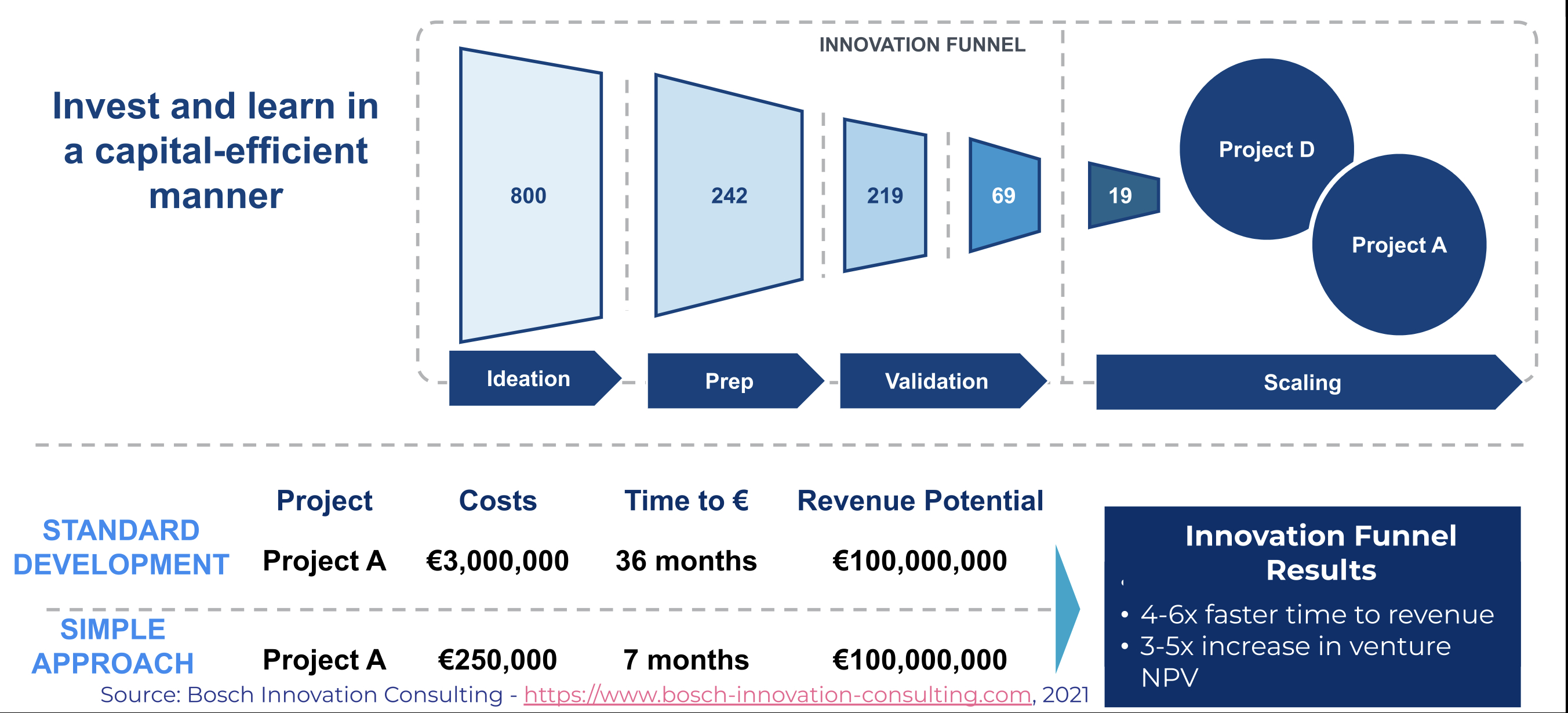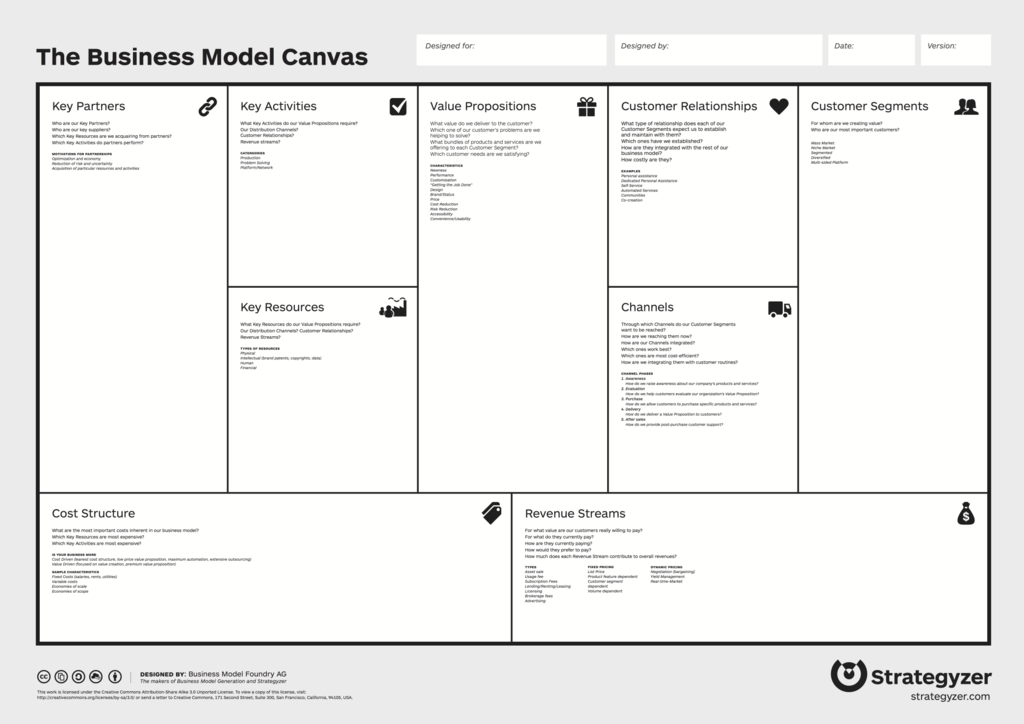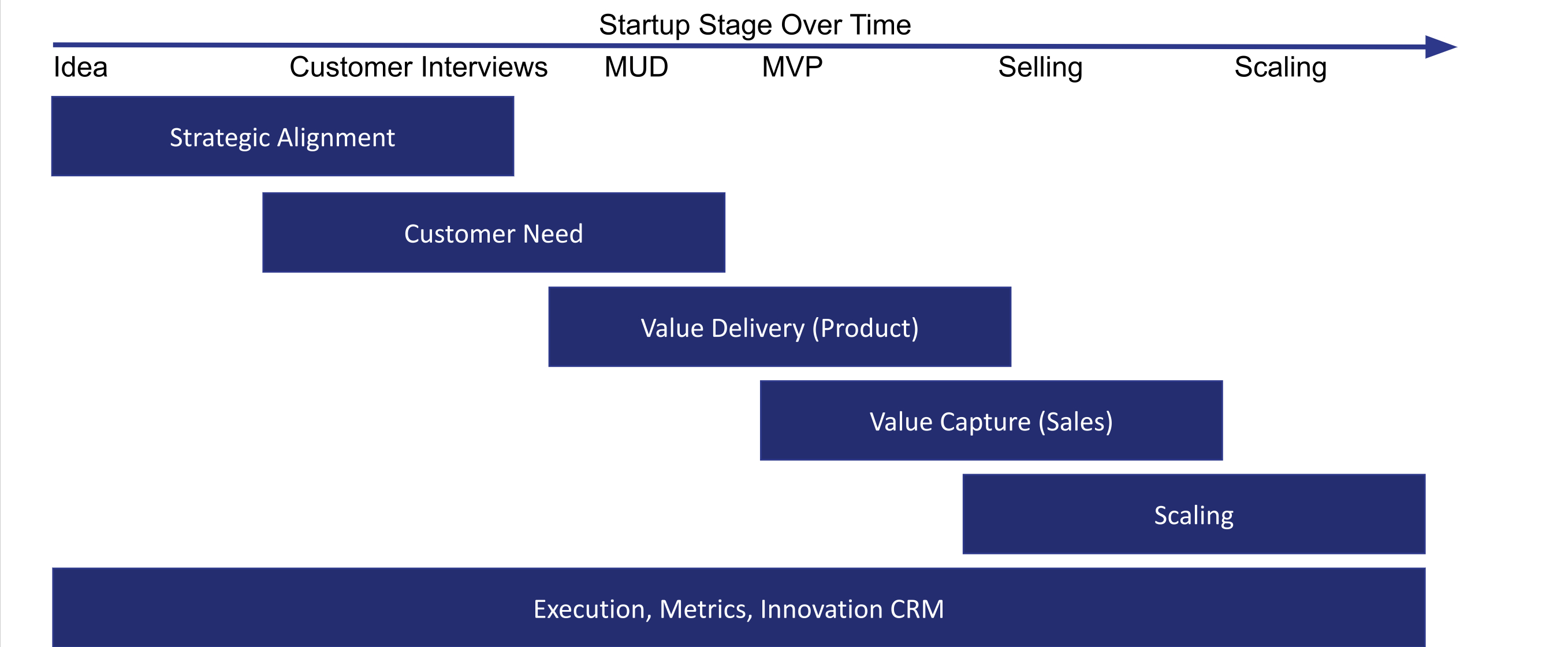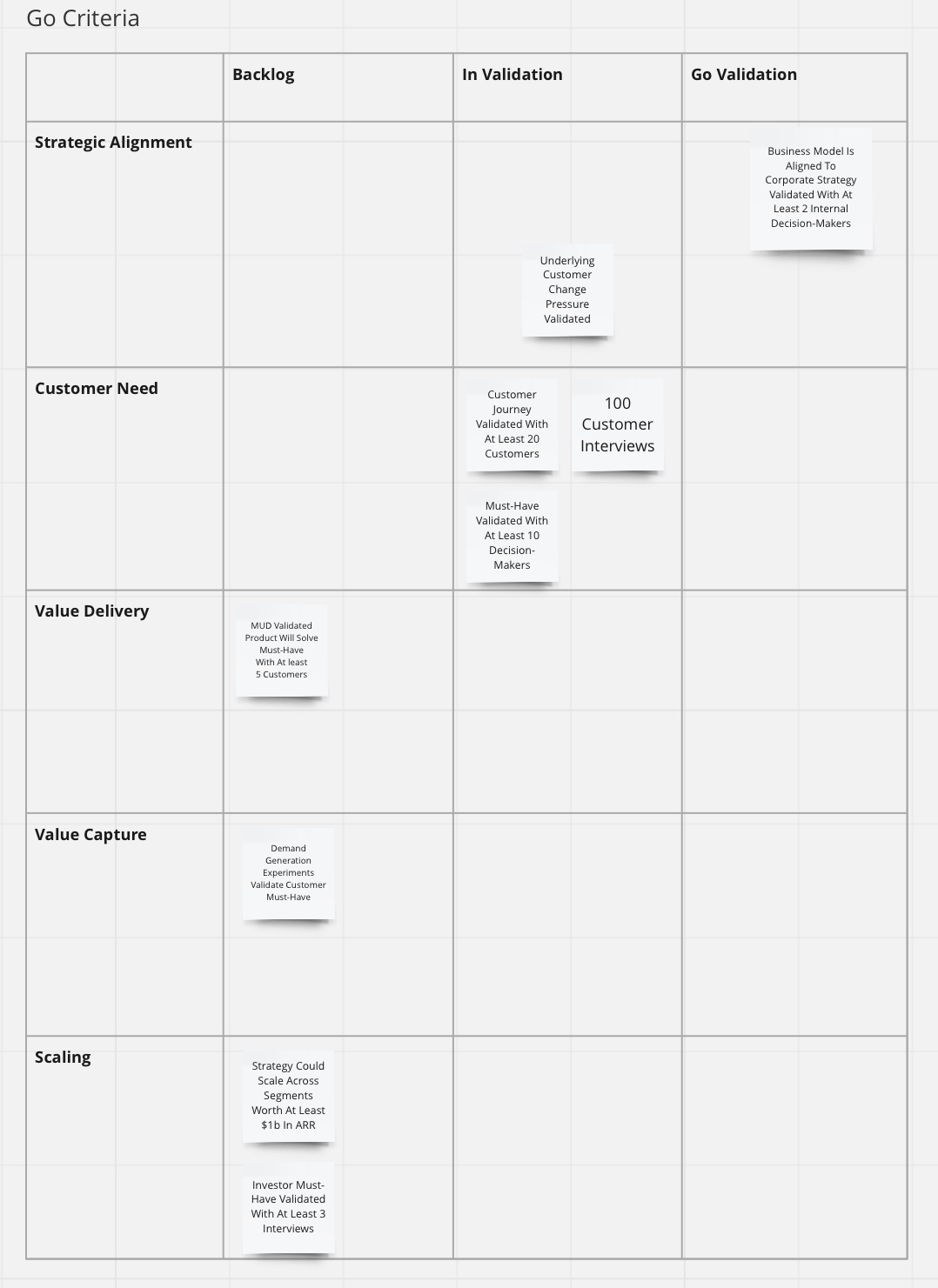Creating An Innovation Culture Using Go/No Go Criteria
What Is Validation?
In the startup world, everyone talks about “hypothesis-driven testing,” “validation,” and “experiments.” Over the last 10 years, I have run over 1,000 startup and corporate innovation teams through programs based on the Business Model Canvas. It’s great for prompting entrepreneurs to focus on innovating the whole business model and not just the product. As a practical matter, the challenge of a canvas-based startup validation process is that it doesn’t prioritize which validation questions to ask first, what constitutes a good-enough answer to continue, what to do next and when to stop working on a bad opportunity.
One way to think about starting a new company is that it’s a process of answering a set of critical questions in order. Examples:
- Is the opportunity a strategic fit?
- What prioritized customer segments does it target?
- Is the “must-have” for the decision-maker in the target customer segment validated?
- Is the market big enough?
- Is the product technically feasible?
- Is the sales process scalable?
- Is this the right team to address the upcoming critical questions?
- Is this a repeatable, scalable, potentially profitable business model?
- …
All this experience has let me see where teams struggle. The simple fact is that starting a company and testing a new business model is complicated. Teams struggle when they use canvases. Whatever process we create has to:
- Cut down on the number of problems a team is trying to solve at any one time
- Indicate to a team when they have solved a particular and can move forward
- Indicate when the team can’t solve a critical challenge and have to pivot the business model they are testing
- If the team has to pivot, what problems they should look at to guide where to pivot to
- Let the team assess if their opportunity is a Go (continue) or a No Go (stop) at any particular stage of the process
- If the team is working in a larger organization, for example, as a corporate startup, provide a structured framework for accumulating process metrics and strategic insights based on the problems a team was as able to solve and where it hit roadblocks
If we want to make innovation a proper discipline that we can improve, the first question to ask is a hard one – is there a common set of critical questions that work for a wide range of teams who start at the idea phase that they can follow all the way through scaling? I’ve been lucky enough to found and scale software, B2C internet, B2B internet, pharmaceutical, and medical device companies as well as run almost 2,000 startups and corporate innovation teams through accelerator programs. After all this experience, I can say the answer is yes.
The SIMPLE Validation Framework
Below is a schematic for the SIMPLE Framework (Scalable Innovation Management, Portfolio, and Lean Execution). It shows the “lanes” of experiments a team needs to be running from ideation to scaling:
In the early stages, teams focus on Strategic Alignment-lane challenges – are they targeting a rapidly changing market, strategically aligned with their parent company, able to garner political support (in the case of a corporate team), venture capital fundable (in the case of a startup), or able to scale social impact (in the case of social entrepreneurship). After they have a good strategic frame, teams can search for the customers that have challenges they can address within that strategic frame. After they find customers and understand their challenges, they can start to build prototypes (Minimum Useful Demos and Minimum Viable Products), and so on. If the MUD or MVP isn’t seen as a must-have by the target Customer Segment, they can iterate their product or back up a step and change Customer Segments. If they can’t find a Customer Segment that works, they can back up another step in the Framework and generate new ideas based on their Strategic Alignment. If that doesn’t work, it’s time for a change of strategy altogether. (This is very valuable for companies because they can run a Validation-Driven Strategy – make strategic guesses and use the SIMPLE process to get a lot of validation data rapidly and inexpensively. If the strategy doesn’t validate, the company has avoided wasting a lot of time and money on a misguided big bet.)
Running A SIMPLE Process
How would we do that for the SIMPLE Framework? Let’s look at the instantiation of the framework we developed for one of our corporate customers, Bosch. They run a multi-stage innovation pipeline with Phases for Ideation, Preparation (Customer Interviews), Validation (MUD, MVP, and Sales in two Phases). The diagram below shows the number of teams we have run through each stage:

In each Phase, a team must validate that solving a customer must-have need will lead to a purchasing decision. As a team gets further and further through the process, the quality of evidence required by a team to make a Go decision goes up. For example:
- Ideation Go Criterion: Strategic Alignment: Interviews with at least two senior managers confirming that the team’s idea is targeting important customers and a strategic focus
- Preparation Go Criterion: Customer Need: Interviews with at least 20 decision-makers in the target customer segment indicating the team can solve a must-have problem
- Validation 1 Go Criterion: Value Delivery: 3 signed Letters Of Intent to purchase after an MVP test
- Validation 2 (Incubation) Go Criterion: Value Capture: Product sales to at least 10 customers
Making Go/No Go Decisions SIMPLE
In fact, teams can create a Kabam-like board with their Go Criteria and whether they have the level of validation they need to declare a Go at the end of the Phase. Here is a simplified example for a team in the Preparation Phase:
If the team using this simplified example is at the end of their Preparation Phase, it’s clear to them they are a No Go as only one of their Criterion has reached the Go level of validation. In terms of the order in which a team needs to work, they should be working on those tasks closer to the top of the Board and worry about the tasks toward the bottom of the Board later in the process. If they need to pivot, they should look up the Board to the tasks above and redo those with a different hypothesis.
Creating A Culture Of Innovation
I was lucky enough to co-found the Chorus Group at Eli Lilly almost 20 years ago, where we solved many of these challenges for Pre-Clinical through Phase 2 pharmaceutical development. Our critical insight was that any innovation process has to provide a rich enough decision-making environment for the team to make “a portfolio decision.” That is, given all the options in front of the team, which is the best one to pursue given the risk, cost, time, and potential reward. That includes continuing with the current option, pivoting to a new option, or stopping altogether. Here are teams at Bosch celebrating their Go (green Ampelmann aloft) and No Go (red Ampelmann aloft) decisions:

I work with lots of companies that want to create a culture of innovation. Often they want to do this by having innovation spaces, “celebrating innovation,” having successful entrepreneurs talk to employees, putting an ideation platform in place to solicit employee ideas, investing in external startups, having managers mentor external startups, investing in corporate venture capital, creating an “incubator” with a few internal startups in it, …. None of those work because having an innovation culture is about having a process that senior managers trust to get innovative products to market and scale while stopping bad ideas before the company makes big investments. The ability to make accurate Go/No Go decisions at the team level is what creates a culture of innovation. Of course, having coaches to help the team make accurate decisions and give them context from other teams is invaluable, but the role of the coach is to help the team run a good process, not play the game.
If a company wants to innovate and can’t trust its teams to run a good process is analogous to a CFO not being able to trust the company’s accountants generate accurate financial ledgers. If the ledgers are inaccurate, the CFO is trying to make financial decisions blind. If a company is trying to innovate and can’t trust its innovation teams, it too is blind. Getting to this place is hard work and that is why most companies don’t invest a lot in internal innovation – it’s clear they don’t trust their process and their employees to generate results. What’s exciting about working with companies like Bosch, is by having a solid SIMPLE-based Go/No Go decision-making framework gets teams to greater than 95% accuracy. This is despite most of the team members being first-time entrepreneurs.
A Better Team-Level Decision Making Process Makes Innovation Faster and Cheaper Than Traditional Product Development
Using a robust Go/No Go Criteria-driven process not only creates a culture of innovation, it allows the innovation process to be metrics-driven and generate strategic insights. At Hypershift Systems, we’ve built a software system that can track team-level information and the speed of transition of Go Criteria from Backlog to In Validation to Go Validation. The value of measuring the process is clear. Bosch has been able to get from ideas to revenue 4-6x faster. The Chorus team at Eli Lilly can get from the Pre-Clinical Stage to Clinical Proof-Of-Concept 3x faster and at less than 1/6th the cost of the traditional process, our UC Berkeley startups are 3x more likely to generate revenue and get external funding compared to before implementing rigorous validation processes. This is a big idea – getting more rigorous and driving decision-making down to the team level makes teams go faster and work cheaper.
A SIMPLE Process Generates Strategic Insights
Finally, using a software system to track progress make it clear where teams are failing to reach validation. Are they never getting to a Go-level of validation for certain strategies or customer segments? Are their MVP tests failing to lead to customers ordering the product? Are they struggling to scale their sales process in later stages? This shows where a company might need to change strategies, target different customers or improve internal capabilities to make the teams more successful with these challenges. This is not information a company is going to get out of a Canvas-driven process.
Conclusion
Looking at the innovation process as one driven by clear Go/No Go Criteria at the team level provides a number of critical advantages:
- The SIMPLE process works across essentially every kind of business model, team type, and industry: B2B, B2C, B2B2C, startup, corporate, social venture, software, hardware, healthcare, government, …
- Teams can quickly learn to accurately and comfortable kill bad ideas even if they are first-time entrepreneurs
- Managers don’t have to try to pick winners from pitches and can use their purview to make better strategic decisions based on aggregate team results
- SIMPLE process-level data generate insights to improve the process, identify where teams need more support, and validate a company’s strategies
- Accurate Go/No Go Decisions at the team level are what creates a culture of innovation
References
There is a lot of good work on making innovation more systematic:
- Bosch: Scaling Large Company Innovation for Strategic Advantage
- A decade of innovation in pharmaceutical R&D: the Chorus model
- Steve Blank’s The Startup Owner’s Manual: The Step-by-Step Guide for Building a Great Company
- Lean Analytics: Use Data to Build a Better Startup Faster
- Disciplined Entrepreneurship: 24 Steps to a Successful Startup






